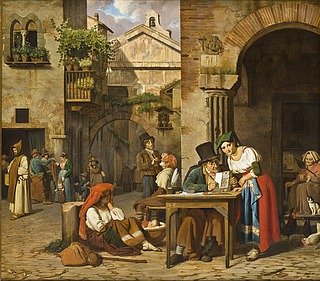
As his wealth increased, the Danish sculptor Bertel Thorvaldsen became a dedicated collector of paintings, and supported artist-colleagues in need by buying their works of art. The collection of paintings at Thorvaldsens Museum contains nearly 400 paintings, over 300 of which were collected by the sculptor himself. The aim of this paper is to investigate the motifs of this collection broadly, in order to ascertain which motifs by Northern painters Thorvaldsen seems to have valued most. Special focus is given to the absence of paintings with motifs drawn from Norse mythology, which became an increasingly beloved theme in the Nordic countries during the years after the turn of the century.
This paper was delivered at the conference “Another Horizon, Northern Painters in Rome 1814–1870,” on October 19-20, 2015 in Rome, by research fellow Kira Kofoed of Thorvaldsens Museum, Copenhagen.
It is still unknown precisely when Thorvaldsen started to collect paintings. During his first years in Rome, from 1797I until some years after 1803, which was the year of the first major commissionII of a statue—namely, Jason, A822 —in marble by the banker and art collector Thomas Hope, Thorvaldsen was quite poor, and even worked as an assistant of the English landscape painter George Augustus Wallis in order to get by economicallyIII. Thorvaldsen drew and ultimately painted figures into Wallis’s landscapes.
In 1808IV Thorvaldsen was appointed member of and professor at the Roman Accademia di San Luca, for which he obtained a salary—and as a result, he received still more commissions. By 1818, his former patron, the Danish diplomat Herman Schubart, wrote: “Thorvaldsen does not need me anymore—he is so infinitely richer than me.”
In fact, already during the stay in Rome of the Danish painter C. W. Eckersberg, from 1813 until 1816V, Thorvaldsen’s collection was large enough to impress the painter, who wrote in November 1813VI to J. F. Clemens, his professor at the Royal Academy in Copenhagen:
“… and now to be in Rome, to live in the same house as Thorvaldsen, to be able to take advantage of his art collection and library, which is more pleasant than any I could ever have encountered …”
As you heard yesterday, Eckersberg was indeed one of the many visitors who came to see Thorvaldsen’s collection, and who was inspired by it—a point that I will return to briefly later on.
By around 1838, Thorvaldsen had collected at least 260 paintings; a listVII of these was drawn up at this time. By his death in March 1844VIII, Thorvaldsen’s collection consisted of 356 paintings, or perhaps even 364, depending on which lists are consulted. 53 paintings were sold by Thorvaldsens Museum at a public auctionIX in 1849, however, as they were regarded as inferior compared to the standard of the rest of the collection. The number of paintings listed in the first catalogueX of the collection, published by the Thorvaldsens Museum in 1849, is 311.
Even after Thorvaldsen had died, the collection continued to grow—as it still does whenever the museum can raise the money needed to buy a painting that relates closely to Thorvaldsen, his works, his whereabouts, or his network. In fact, Thorvaldsen’s will, in which he donated most of his belongings and collections to the city of Copenhagen, stipulates that Danish artists are to be supported in the future, in order to enrich and promote Danish art—and thereby also his future painting collection.
And now to the statistics.
According to the first curator at Thorvaldsens Museum, Ludvig Müller, who wrote the first museum cataloqueXI published 1847-50, the content of Thorvaldsen’s collection of paintings consisted of 311 paintings. The paintings used for this conference are all paintings known (or presumed!) to have been purchased before the death of Thorvaldsen, and the focus is furthermore limited only to include works by Nordic and German painters.
As you can see in the table below, the collection consists of two parts—old masters and contemporary art. The contemporary works form by far the largest group—82%. Of these, 74% are by Nordic painters—primarily Danish and German. Quite a few of the paintings—older and contemporary—were copies or replicas, as was normal for art collecting at the time. If the first painting was taken, one could easily settle for a replica by the same artist, or even for a copy by another artist. The same logic applied to Thorvaldsen’s own statues and reliefs, of which many custumers could have had copies.
| According to L. Müller, 1849 | Number | % |
| Paintings in total | 311 | 100% |
| Old masters | 57 | 18% |
| Of which: | ||
| Italian | 33 | 58% |
| Copies of Italian paintings | 10 | 18% |
| Dutch etc. | 14 | 25% |
| Old masters in total | 57 | 18% |
| Contemporary paintings in total | 254 | 82% |
| Of which: | ||
| Italian | 29 | 11% |
| French | 11 | 4% |
| English | 4 | 2% |
| Dutch | 3 | 1% |
| German | 64 | 25% |
| Hungarian and Slavic | 7 | 3% |
| Swedish and Norwegian | 19 | 8% |
| Danish | 104 | 41% |
| Miniature, porcelain paintings etc. | 13 | 5% |
| Contemporary paintings in total | 254 | 82% |
As seen in the table below, 74% of the contemporary paintings are by Nordic painters—primarily Danish and German.
| According to L. Müller, 1849 | Number | % |
| Paintings in total | 311 | 100% |
| Contemporary paintings in total | 254 | 82% |
| Of which | ||
| Danish | 104 | 41% |
| German | 64 | 25% |
| Swedish and Norwegian | 19 | 8% |
| Contemporary paintings by Nordic painters in total | 187 | 74% |
In the table below we will have a closer look at the paintings’ motivic content.
| Types of motifs | Number | % | Of which Italian motifs | % |
| Landscape paintings (incl. vedute, architecture etc.) | 86 | 45% | 35 | 41% |
| Portraits | 15 | 8% | 6 | 40% |
| Genre paintings (see below) | 81 | 42% | 39 | 48% |
| Other (still-life paintings, animals etc.) | 9 | 5% | 3 | 33% |
| In total | 191 | 100% | 83 | 43% |
| Genre paintings, consisting of | ||||
| Historic motifs | 9 | 11% | 2 | 22% |
| Religious motifs | 15 | 19% | 0% | |
| Motifs from everyday life | 51 | 63% | 37 | 73% |
| Mythological motifs | 6 | 7% | 0% |
The two major motivic categories are landscapes (also including townscapes) and genre paintings. Genre paintings are here understood as specified in the table in a broad sense. The motifs taken from everyday life are by far the most prominent group with 63%. Yesterday you saw, among others, Ernst Meyer’s 1829 painting A Roman Street Letter-Writer Reading a Letter Aloud to a Young Girl, B266.
Ernst Meyer: A Roman Street Letter-Writer Reading a Letter Aloud to a Young Girl, B266.
How did Thorvaldsen collect paintings? The subject has not yet been fully investigated, and the time limit allows me only to provide a few major examples.
Thorvaldsen could of course simply buy the works that he wished to own, or buy paintings in order to encourage the artist—as was the case with the painting by the German painter August Riedel, A Neapolitan Fisherman and His Family, B150, from 1833XII. The paintings by the Danish painter Albert Küchler painting Roman Peasants Buying a Hat for Their Little Son, Who is to Be an Abbate, B246, dated 1840, and Wilhelm Marstrand October Festival Evening Outside the Walls of Rome, B258, from 1839XIII, were bought at an exhibition in 1840XIV.
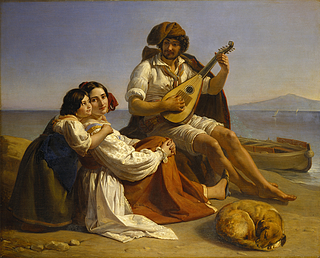 |
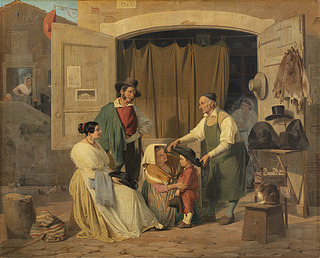 |
| August Riedel: A Neapolitan Fisherman and His Family, B150. | Albert Küchler: Roman Peasants Buying a Hat for Their Little Son, Who is to Be an Abbate, B246. |
Wilhelm Marstrand: October Festival Evening Outside the Walls of Rome, B258.
At least one of these two paintings, B291 and B292, by the Danish painter Jørgen Sonne, was also acquired by Thorvaldsen. Which painting the still-extant receiptXV to Thorvaldsen pertains to, however, remains unknown.
 |
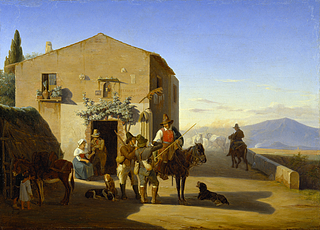 |
| Jørgen Sonne: A Battlefield on the Morning After the Battle, B291 | Jørgen Sonne: Roman Country People Outside the Osteria at Ponte Mammolo, B292. |
Another way for Thorvaldsen to enlarge his collection was apparently by lending money to artist colleagues in need—for instance, to Ditlev Martens, who in 1837XVI needed money for his travel from Rome to Hamburg—money which was apparently never paid back, as the painting used as collateral, St. Peter’s From the Via Sacra, North of Rome, B260, is still in Thorvaldsen’s collection.
Ditlev Martens: St. Peter’s From the Via Sacra, North of Rome, B260
The two tree-studies, B139 and B140, by the German painter Johann Christian Reinhart are also evidence of a loan that was not paid backXVII.
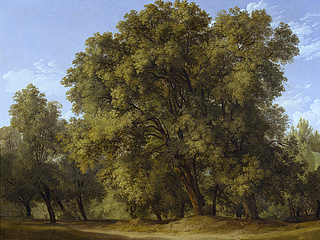 |
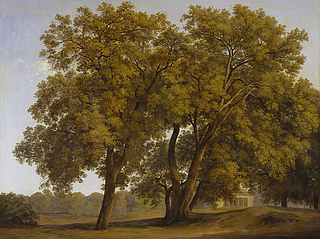 |
| Johann Christian Reinhart: Forest Scene, B139 | Johann Christian Reinhart: View of the Gardens of the Villa Borghese, B140 |
Yet another example of collecting is the purchase of two paintings by the Danish painter Jens Juel, which Thorvaldsen bought from a Danish widowXVIII, daughter of the Danish etcher G. L. Lahde. The widow wanted to sell the artworks, of which even the future kingXIX of Denmark had had copies made, in order to give her seven children a proper education.
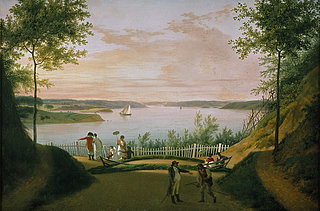 |
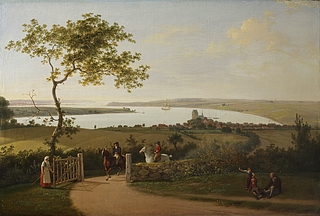 |
| Jens Juel: View of the Little Belt from Hindsgavl, Funen, B237. | Jens Juel: View of the Little Belt from a Hill near Middelfart, Funen, B238. |
There are only very few examples of Thorvaldsen ordering a painting by an artist—and most of these seem to be copies or replicas; but this subject is still to be investigated thoroughly. An example might be found, however, in a documentXX from the Italian painter Michelangelo Pacetti to Thorvaldsen.
Thorvaldsen, in short, did support artists in need, buying their paintings in order to encourage them, or just because he liked their paintings—presumably well aware that having sold a painting to the Danish national icon could be a very good recommendation for the future. The Italian painter Giambattista Bassi for instance considered it likely that a certain commission of a painting by him was entirely due to the fact that the customer had seen one of his paintings in Thorvaldsen’s collectionXXI.
A final category of purchase consists of paintings that were given to Thorvaldsen as gifts—as, for example, the painting by the German painter Carl Gustav Carus, A Prehistoric Barrow by Moonlight, Nobben on the Island of Rügen, which seems to have been a present from Carus to Thorvaldsen during the sculptor’s short stay in Dresden 1820XXII.
Carl Gustav Carus: A Prehistoric Barrow by Moonlight, Nobben on the Island of Rügen, B108.
This painting by Carus leads to the final subject of this paper—the absence of motifs drawn from Norse mythologyXXIII. Despite numerous exhortations by prominent Danish personalities—such as the crown princeXXIV, prominent poets, and his own patron Schubart—to produce works with motifs drawn from Norse mythology, Thorvaldsen did not leave behind even one single finished work of the sort. In general, however, the rediscovery of Norse motifs did form an important part of Danish national self-understanding, especially in the years following 1800. Nor did the myths of the north find their way into Thorvaldsen’s collection of paintings in any substantial number. In fact, only two paintings numbered by Müller can be said to make rather clear references to the Nordic past—both of which display prehistoric monuments as the main motif. These would be the aforementioned painting by Carl Gustav Carus, and another painting by Johan Thomas Lundbye: Dolmen at Raklev, Røsnæs, B255, dated 1839.
Johan Thomas Lundbye: Dolmen at Raklev, Røsnæs, B255.
Another painting, which was not mentioned in the official catalogue by Müller, is by Thorvaldsen’s friend, the Danish painter C. F. Høyer, entitled Ossian Carrying his Dead Brother Gillan, Followed by Fingal’s Dog Bran, B408, c. 1805-1808. It is unknown precisely when and how this painting came into Thorvaldsen’s possessionXXV.
C.F. Høyer: Ossian Carrying his Dead Brother Gillan, Followed by Fingal’s Dog Bran, B408.
And what would be the cause of this absence of Norse motifs? Thorvaldsen in fact gives the reason himself in a letter dated 16.2.1807XXVI to C. F. Hansen, the Danish architect in charge of rebuilding the Royal Danish Castle in Copenhagen: “I intend to make use of Greek mythology, inasmuch as it is the most cultured and consequently the most valuable for art.”
Thorvaldsen, in short, held Greek mythology to be superior to others. In fact, in Denmark, a fierce dispute on this very subject was underway from 1812 onward. The basic point of contention was the extent to which it was defensible to employ motifs from Norse mythology in contemporary art, given that Christian and classical antique motifs had so long been available to draw on. The debate between the two sides was hardly placid: anonymous slander and personal attacks among the parties were a matter of course. And both sides sought trump cards in alleged statements by Thorvaldsen, which were cited in defense of both of the two main standpoints. I have explored this subject more thoroughly elsewhereXXVII ; the main point is that, thanks to Winckelmann, ancient Greece came to be taken as an image of the ideal society, with democracy, freedom, rational science, advanced philosophy, and the cultivation of the beautiful and the good as its cardinal principles. Classical art was regarded as reflecting this ideal society in the purest possible way, and hence as worthy of emulation.
In the wake of the Napoleonic Wars and the state bankruptcy that followed, however, an acute demand emerged in Denmark for a unifying and edifying heroic image. It was in this context that the “Mythology Dispute” first began flaring up in earnest, and the Royal Academy of the Arts played a central role in this game.
It is clear from the letter cited above that Thorvaldsen wished to work on the basis of classical myths known to all—especially because he wanted to live and work in Rome, where the motifs drawn from Norse mythology had little hope of commissions. In fact, the aforementioned patron Schubart mentions this practical issue in a letter to Thorvaldsen concerning his wish to make use of classical mythology: “Your thought about the immortals whom you will render eternal at the gate of Christiansborg Palace is supremely fitting. It is better than if you had taken something from Scandinavian mythology, which is only poorly known; whereas everyone knows and loves Minerva, Jupiter, Nemesis, and Hercules. In Rome, moreover, one can hardly work on anything other than Roman and Greek gods and heroes.”
Accordingly, it seems entirely reasonable to assume that the sculptor had no urge to make use of Norse mythological motifs in his own work—or to collect them as paintings. His debt to the ideals of Neoclassicism and the theories of Winckelmann, probably along with business instincts befitting a sculptor of international stature, weighed more heavily on Thorvaldsen than did exhortations from the fatherland. As early as 1804, Thorvaldsen seemingly preferred to renounce his citizenship than to return home to Denmark, where his prospects for making a living as a sculptor were dim indeed. Already at that early point, it was clear that European Neoclassicism was where Thorvaldsen’s future lay. To have embarked on projects drawn from Norse mythology would not only have portended a break with the ideals of Neoclassicism as Thorvaldsen clearly understood and applied them, but would also have meant a more restricted and less prosperous audience; it would have meant that he would have had to start from scratch in becoming conversant in the symbolism, drapery, weapons, tools, and architecture of another legendarium; and it would have meant doing so at such an early stage, in which what mattered most was being discovered and set on firm footing. This also suggests, at least to a certain extent, that Thorvaldsen’s collection of paintings was indeed—as were his other collections of coins, casts, etc. —used as a sort of pattern-book, a place to look for inspiration. —Add to this, finally, Thorvaldsen’s clear preferences for genre and landscape paintings that could remind him of his life in Rome and elsewhere, much as a photo album does for us today.
Indeed, to sum up: Thorvaldsen’s own collection of paintings can be seen as a counterpart to his own world of sculpture, which consists mainly of portraits and mythological motifs. In the painting collection, instead, motifs from everyday life and landscapes play the largest role.
C. W. Eckersberg, who was cited in the beginning, can also be cited as an concluding remark on the Nordic painters in Rome and Italy. In the same letterXXVIII, Eckersberg wrote: “I strive continually and with all my might to make use of the time and opportunity [here in Rome], and to attain as much perfection in art as I possibly can.” He writes of “being led on the good, true path of coming to know nature’s heavenly magic,” and about having “progressed to a perfection that only Nature, and the thorough study of our masters the Greeks, can lead to.” Despite what he had stated about Thorvaldsen’s art collection, Eckersberg continues: “One should actually look for painters in Paris, and a collection of the old masters’ paintings too; and thanks to the French for arranging it so that everyone can take advantage of it. Then on the other hand there is a Vatican, a Museum Pio Clementinum, which is just as marvelous as the remains of ancient Rome and the beautiful nature in this region of Italy.”
Thorvaldsen’s collection of paintings sums it all up. Like the French, he offered a private collection to public view—first in his home in Rome, and later to the people and visitors of Copenhagen, by donating his collections to the city. Thorvaldsen thus gave the people the possibility of being “led on the good, true path” and of “progress[ing] to a perfection that only Nature, and the thorough study of our masters the Greeks, can lead to.” In fact, when the museum building was under construction and the Thorvaldsens Museum committeeXXIX set up the rooftop tree, the Danish painter Bolette Puggaard arranged that the French Tricolore be placed at the very top of the MuseumXXX, as a sign of democracy—at least in art. One year after Thorvaldsens Museum opened, the Danish democratic constitution was signed; and Thorvaldsen and his collections play their own important role in this history.
I wish to thank David Possen for his brilliant editorial assistance.
Sidst opdateret 11.08.2025
Thorvaldsen ankom til Rom første gang 8.3.1797.
Jf. Thorvaldsen-kronologien, tidligst 19.3. – senest 21.3.1803, og refererenceartiklen Jason og Hopes bestilling.
Jf. Jürgen Wittstock: Geschichte der Deutschen und Skandinavischen Thorvaldsen-Rezeption bis zur Jahresmitte 1819, [Dissertation] Hamburg 1975, p. 40; samt Monika von Wild: George Augustus Wallis (1761-1847). Englischer Landschaftsmaler. Monographie und Oeuvrekatalog, Frankfurt am Main, 1996, pp. 129-146.
Jf. Thorvaldsen-kronologien, 6.3.1808.
Jf. Thorvaldsen-kronologien forlod Eckersberg Rom 13.5.1816.
Jf. brev af 13.11.1813.
Se hertil den endnu ikke præcist daterede fortegnelse over Thorvaldsens malerier.
Jf. Thorvaldsen-kronologien 24.3.1844.
Jf. Thorvaldsens Museum auktionskataloger 1849, op. cit.
Jf. Müller, op. cit.
Jf. Müller, op. cit.
Jf. kvittering af 19.4.1833.
Jf. kvittering af 14.8.1840.
Kunstforeningen af 1825, jf. kvittering af 14.8.1840.
Jf. kvittering af antagelig 1834-1838.
Jf. kvittering af 2.7.1837.
Jf. kvittering af 24.6.1828.
Dvs. enkefru L.C. Panum, der var datter af Thorvaldsens ungdomsven, G.L. Lahde.
Se hertil breve af 14.3.1843 og 25.10.1843, der dokumenterer maleriernes historie og Thorvaldsens køb af dem.
Dvs. den daværende danske kronprins Christian Frederik, senere Christian 8.
Se hertil brev af 26.9.1833.
Se hertil Bassis brev til Thorvaldsen af 17.8.1828.
Jf. Thorvaldsen-kronologien, der angiver, at Thorvaldsen ankom til Dresden 6.9.1820 og forlod byen igen 12.9.1820.
Meget i det følgende er citeret fra eller uddraget af artiklen Nordisk mytologi, af Kira Kofoed, 2014.
Dvs. den daværende danske kronprins Christian Frederik, senere Christian 8.
Et brev af 30.10.1808 fra Høyer til Herman Schubart (Håndskriftafdelingen, Det kongelige Bibliotek, NKS 2337-2o) dokumenterer imidlertid, at Høyer under sit romerske ophold udførte flere kompositioner af Ossian. Dette kunne være et af dem, og maleriet kunne være efterladt som gave til Thorvaldsen mellem 1805 og 1811, hvor han forlod Rom igen, jf. Arkkataloget, THM.
Se hertil brev af 16.2.1807 fra Thorvaldsen til C.F. Hansen, hvor Thorvaldsen skriver følgende: “jeg [mener] at gjøre Brug af den Græske Mytologie, saa som samme er den mest cultiverde og følgelig den værdigste for Konsten”.
Jf. artiklen Nordisk mytologi, af Kira Kofoed, 2014.
Jf. brev af 13.11.1813.
Dvs. Comitteen for Oprettelsen af Thorvaldsens Museum.
Se hertil Maria Puggaards brev, sandsynligvis sommeren 1842, der omtaler Bolette Puggaards dristige handling:
”[..] i Vinter da Krandsen skulde sættes paa Bygningen bandt Moder en stor Krands dertil, og havde den Dristighed (i vore oprørte Tider) at hænge en tricolore Fane øverst op paa den; vi andre søgte at afskrække med Hovedvagten og Tiltale, som jo hører til Dagens Orden; men hun lovede nok at skulle forsvare sin Fane, om det saa var for Kongen selv; Frihed i Konsten, mente hun, har Thorvaldsen indført, at den maae bestaae, maae være vor fornemste Atraae, og hans Museum skal staae frit fra enhver Forbindelse med Slottet eller andet deslige.”